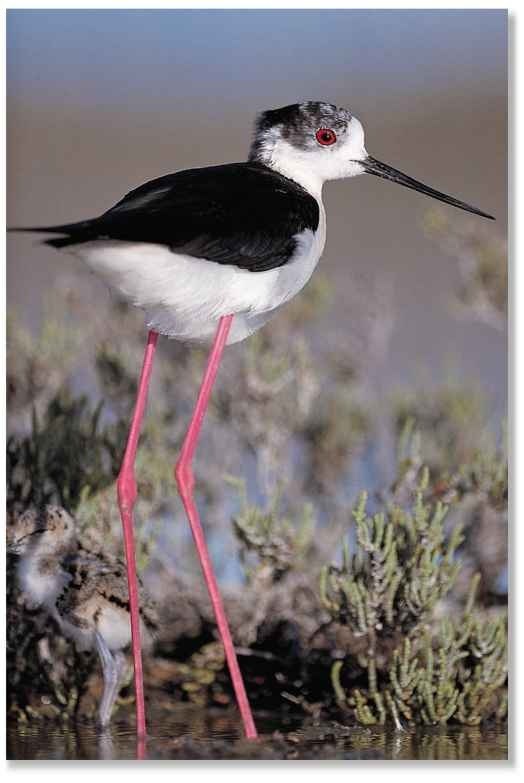ORDER
Charadriiformes
FAMILY
Recur virostridae
GENUS & SPECIES
key features
• Performs aerial and ground displays, such as the “parachute display” and the”butterfly flight,” the purpose of which remains a mystery
• Measuring up to 14″ long, the stilt’s legs trail far behind it in flight and make it easy to identify
• The stilt’s versatile, sharp bill is perfect for snatching insects or cutting up large crabs before swallowing
where in the world?
widespread throughout Australia as well as coastal and inland regions of New Zealand; also in India, Sri Lanka, Southeast Asia, Africa, Europe, Mexico, Central and South America

LIFECYCLE
The black-winged stilt goes through a series of mysterious displays that observers have yet to explain; it “parachutes,” “butterflies” and performs a “grouping” ceremony.
HABITAT
The black-winged stilt is most at home in extensive shallow wetlands, such as coastal wetlands and lagoons, which are full of insects, as well as small invertebrate prey. Stilts occur in both fast-flowing and still waters and prefer wetlands where there is adjacent open space that’s suitable for nesting and resting. The black-winged stilts also occupy other freshwater, estuarine and artificial environments, such as irrigated fields, and will move seasonally to find adequate wetlands. In areas heavily modified by human activity, stilts must depend upon artificial wetlands, such as scrapes, salt lakes, dams and drainage ponds, some of which y Walking tall are created expressly for wildlife a stilt uses its long legs to
conservation. search for food.
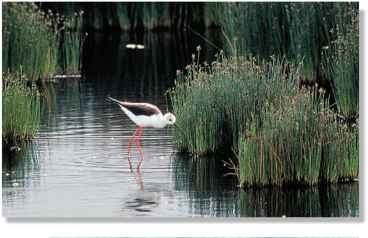
CONSERVATION
The black-winged stilt is not globally threatened. In fact, the stilt’s far-reaching range and local abundance indicate that the species is quite strong and its future appears to be secure. However, on the Hawaiian Islands, the local form of the black-winged stilt, the Hawaiian stilt, has come under pressure principally from the loss of natural wetlands due to urban development and the farming of sugar cane.
# The black-winged stilt is also known as the long-legged plover, longshanks, pied stilt, stilt-bird and dog-bird.
The genus name Himantopus comes from the Greek words for a “strap”and a “foot,” referring to the black-winged stilt’s long legs.
BREEDING
Black-winged stilt courtship begins with preening and bill-dipping, followed by the female assuming a receptive posture. The male then moves from side to side in a semicircle behind the female several times before mating begins. Breeding pairs are most often found in colonies, typically ranging from between 2-50 pairs. Nests are built from flood debris, driftwood, grass, fine twigs and other vegetation, and shaped into a bowl, cone or mound up to 6″ high. Nests are spaced widely on the ground, often among grasses and sedges, although some nests
are made from well-lined masses of floating water weeds.The female usually lays four eggs in a 24-hour interval. Both parents take turns incubating the eggs from 22-26 days, when the downy young hatch.
Fledging takes between 28-32 days, and the young are independent of their parents nearly 2-4 weeks after fledging.
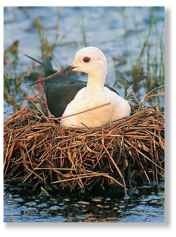
A Sitting on the job A black-winged stilt incubates a nest of eggs.
Baby steps
Three fledglings try out their wobbly legs.

BEHAVIOR
The black-winged stilt exhibits extremely unusual (and largely unexplained) behavior For example, it often forms small groups of 3-4 and performs a “parachute display,” in which the birds leap high into the air and then parachute downward slowly on outspread wings. Some experts speculate that this may be a unique form of predator distraction. It also performs a “butterfly flight” hovering 16-32′ above a spot and then flying off quickly to another site to repeat the procedure. In the also unexplained “grouping ceremony” 3-4 stilts gather together and spontaneously display mild aggression in the form of lunging and pecking at each other before dispersing.
strange stilt behavior
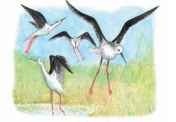
1 Parachute display…
Four stilts engage in their odd habit of leaping into the air and “parachuting” down to their shallow wetland home.
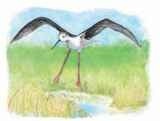
2 Butterfly flight…
A stilt hovers directly above a spot; it will hold this position for a few seconds and then repeat the display somewhere else.
FOOD & HUNTING
Black-winged stilts tend to feed primarily on aquatic prey especially beetles, mayflies and spiders, although mollusks, crustaceans, earthworms and small fish, as well as water plants and their seeds, are also part of the bird’s varied diet.The stilt usually hunts in shallow water or on damp land, but the bird also employs its unusually long legs, neck and bill to feed in deeper water as well. The stilt usually hunts by pecking at clearly visible prey in the water or on the ground. Grasping it with a slightly open bill and swallowing with a backward and forward jerk of the head, the food is quickly eaten.The bird then returns to its original position to search for more food. Larger prey such as crabs, must be cut up by the bill into smaller pieces before they can be swallowed. Other visual methods commonly used by stilts are “plunging,” an underwater
form of pecking or probing in which the bill and head are totally immersed, and “snatching,” which involves pecking at flying insects.
► Adept angler
A stilt expertly snatches a small tadpole.
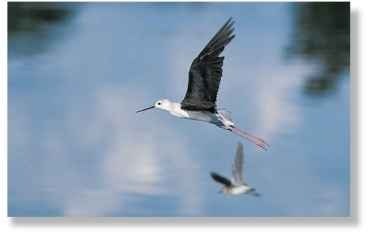
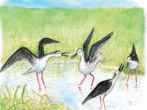
3 Dive and seek…
Four stilts gather, lunging and pecking at each other during another puzzling display known as a “grouping ceremony.”
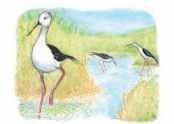
4 Mission over
As the afternoon approaches, the hungry black-winged stilt will join others in the endless search for elusive prey.
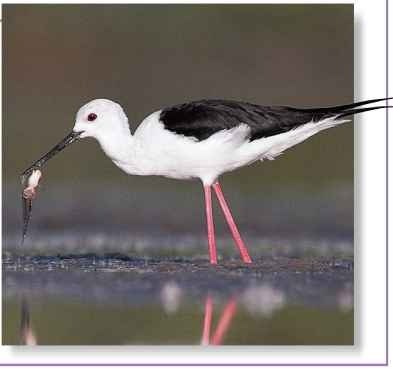
PROFILE
Black-winged Stilt
The black-winged stilt flies gracefully and walks slowly, raising its legs high and taking long steps in the flooded areas it inhabits.
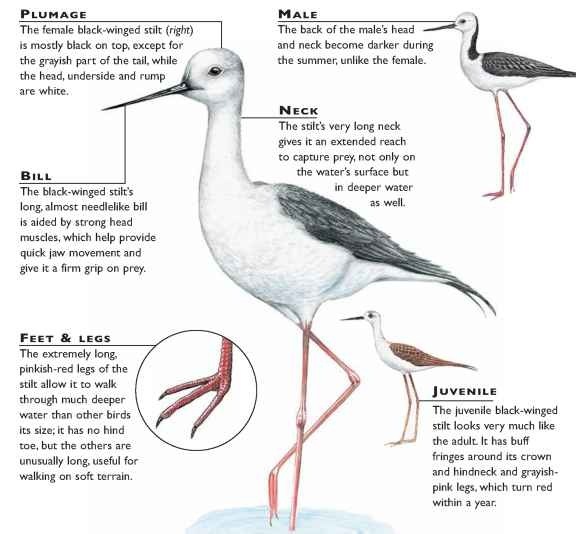
CREATURE COMPARISONS
The black stilt (Himantopus novaezelandiae) and its close relative, the black-winged stilt, both boast the extremely long legs that inspired their “stilt” names. However; the black stilt’s tarsus (connective bone of the ankle) is smaller than the black-wing stilt’s, and it has a slightly shorter neck.The black stilt earns its name by being entirely black, while the black-winged stilt is mostly white except for its wings. Both species frequent wetlands such as swamps, lakes, lagoons, lake shores and mudflats.The black stilt resides only in New Zealand, while the black-winged stilt enjoys a wider range through Australia, India, Sri Lanka, southeastern Asia, Africa and Europe.
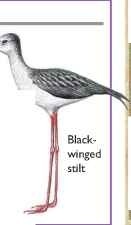
| vital | |
| statistics | |
| Weight | 6-7 oz. |
| Length | 13-14″ |
| Wingspan | 24-28″ |
| Sexual I Maturity | 1-2 years |
| sj; Breeding Season | Seasonal; varies with |
| region | |
| Number of Eggs | 3-6, usually 4 |
| Incubation Period | 22-26 days |
| Fledging Period | 28-32 days |
| Breeding Interval | 1 year |
| Typical Diet | Mainly aquatic prey such as beetles and spiders |
| Lifespan | Up to 12 years |
Related species
• The black-winged stilt is 1 of 2 species in the genus Himantopus, which also includes the black stilt, H. novaezelandiae. Two other genera are | recognized within the Recurvirostridae family: the Recurvirostra, which includes the pied avocet, R. avosetta, and the red-necked avocet, R. I novaehollandiae, and the Cladorhynchua which is I limited to the banded stilt, C. leucocephalus.
